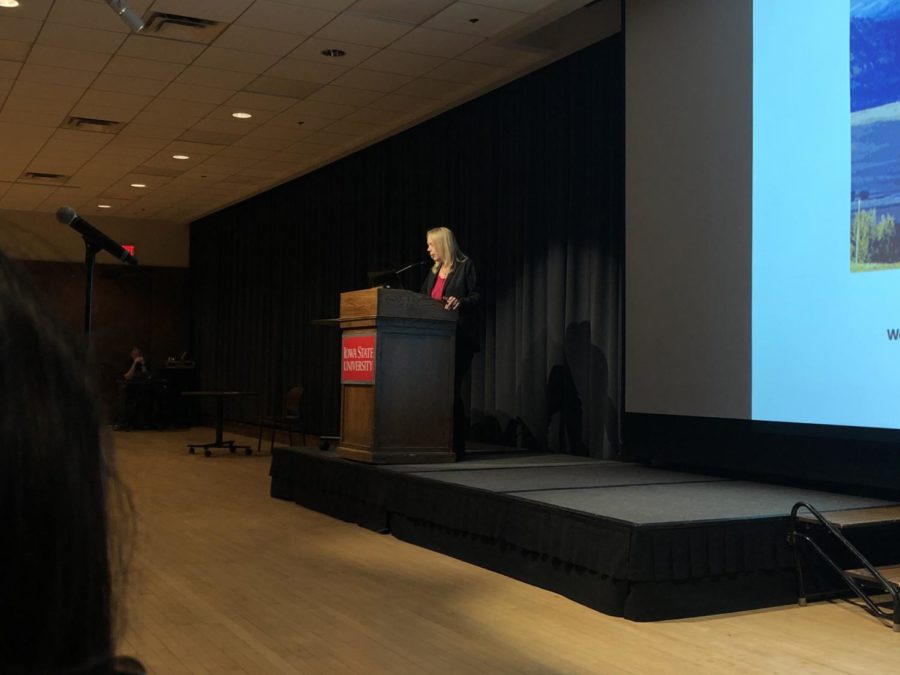Lecturer discusses growing up near secret nuclear facility
Anneke Johnson/ Iowa State Daily
University of Cincinnati professor Kristen Iversen discussed her book about Rocky Flats and growing up near the secret nuclear facility Tuesday in the Memorial Union.
December 3, 2019
Kristen Iversen, professor of creative writing at the University of Cincinnati, discussed some of the content in her book, “Full Body Burden: Growing Up in the Nuclear Shadow of Rocky Flats,” on Tuesday in the Sun Room of the Memorial Union.
“What I wanted to do when I wrote ‘Full Body Burden’ was to tell the story not only through my own eyes and what I experienced, but through the eyes of all the different kinds of people who experienced this story, and how it impacted their lives,” Iversen said.
The term “body burden,” Iversen said, refers to the amount of radioactive material present in a human body, which acts as an internal and ongoing source of radiation.
Iversen’s book details Rocky Flats, the plutonium pit production facility that she and her family lived a couple miles from when she was growing up.
Iversen said writing the book was difficult because it involved disclosing information that she was at one point not able to discuss.
“I was writing about the two things that I had been told and raised never to talk about and never to speak about, and that was Rocky Flats, because a lot of people in my neighborhood worked at Rocky Flats, and you could get fired if you talked about your job, and the other thing is my father’s alcoholism,” Iversen said. “It took a lot of courage in many different ways to write this book.”
Rocky Flats was owned by the Atomic Energy Commission. It operated from 1952 to 1989. In that time, more than 70 thousand plutonium bomb pits were made, each for about four million dollars, Iversen said. Because workers were not allowed to talk about what went on at Rocky Flats, there were all sorts of rumors about what they were doing.
“The rumor in the neighborhood was that they were making household cleaning supplies,” Iversen said. “My mother thought for years that they were making scrubbing bubbles. They were not making scrubbing bubbles.”
Iversen went on to discuss some of what went on at Rocky Flats, particularly the environmental damage it caused. One incident that she detailed involved more than five thousand barrels of radioactive waste, which stood out in the open. The barrels rusted, and the waste leaked out.
Iversen also discussed two fires that happened at Rocky Flats, one in 1957 and one in 1969. She read a section of her book to the audience, in which two men attempt to put out a fire at Rocky Flats.
Following her explanation, Iversen told the story of its downfall.
Nearly every household nearby was affected by cancer, Iversen said. Farm animals were born with defects, and people wanted to know what was going on.
Iversen said the protests began with nuns, who believed that the plant was producing nuclear weapons. As the word got out, people began sitting on train tracks and circling the plant, demanding change.
Iversen said she worked at Rocky Flats for a period of time when she was a student, but eventually quit. She said when she worked there, people said it could never be cleaned up because the proper technology to do so did not exist.
Today, Rocky Flats is buried. Among the buried rooms, Iversen said, are “infinity rooms,” or rooms that are so contaminated they can never be opened.
To wrap up the lecture, Iversen discussed what Rocky Flats looks like today.
Homes are still being built near it, she said, despite protests. She cited studies that showed higher reported rates of breast cancer and leukemia in the area.
Iversen also announced that she has a new book coming out titled “Doom With a View.” It contains essays about Rocky Flats written by scientists, attorneys and others.






